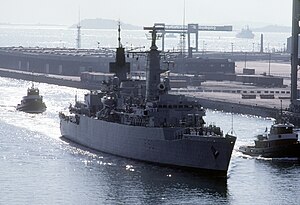 HMS Brilliant enters a port during exercise Ocean Safari 1985 | |
| History | |
|---|---|
| | |
| Name | HMS Brilliant |
| Operator | Royal Navy |
| Builder | Yarrow Shipbuilders |
| Laid down | 25 March 1977 |
| Launched | 15 December 1978 |
| Commissioned | 15 May 1981 |
| Decommissioned | 1996 |
| Identification | Pennant number: F90 |
| Fate | Sold to Brazil 31 August 1996 |
| | |
| Name | Dodsworth |
| Operator | Brazilian Navy |
| Identification | Pennant number: F-47 |
| Fate | Scrapped |
| General characteristics | |
| Class and type | Type 22 frigate |
| Displacement | 4,400 tons |
| Length | 131.2 m (430 ft) |
| Beam | 14.8 m (48 ft) |
| Draught | 6.1 m (20 ft) |
| Propulsion |
|
| Speed |
|
| Complement | 222 |
| Armament |
|
| Aircraft carried | 2 × Lynx MK 3S helicopters |
| Aviation facilities | 1 × double hangar with refuelling facilities |
HMS Brilliant was a Type 22 frigate of the Royal Navy.
Contents
- Royal Navy service
- Falklands War
- 1983–1996
- Brazilian Navy service
- Citations
- References
- External links
Brilliant took part in the only ship-to-ship engagement of the Falklands War, when she and HMS Yarmouth chased the Argentine coaster Monsunen, in the Battle of Seal Cove.